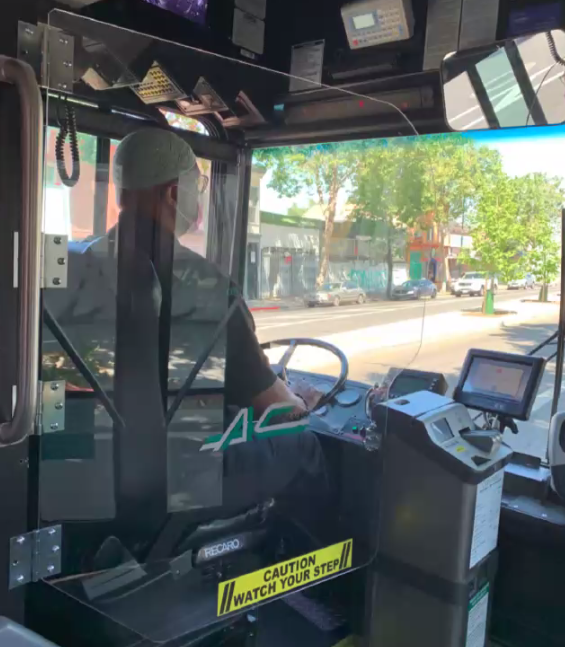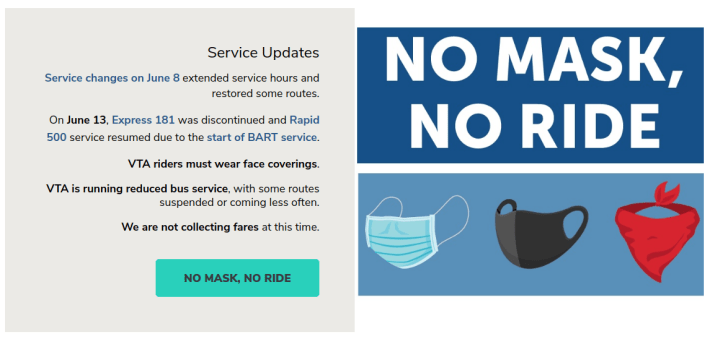The COVID pandemic has forced AC Transit and Santa Clara VTA to run buses without charging fares.
Temporarily abandoning fare collection and having passengers board through the rear doors keeps them away from operators, limiting exposure to the virus. The agencies are now working on expanding contactless fare collection (such as Clipper and mobile apps) and putting up glass shields so that fare collection can resume, probably in the fall. So "...now is an opportunity to look at the larger questions" of fare collection and equity, according to Robert Del Rosario of AC Transit, who participated in a SPUR talk Wednesday about the future of fare-free transit.

The most obvious challenge for fare-free transit is, of course, the loss of revenue. "If transit agencies stop collecting fares, it severs about ten percent for VTA, or $35 million a year," said VTA transportation planner Adam Burger, also at the SPUR talk. "We’d have to turn that into a service cut. Those are really big, scary numbers."
For AC Transit, fare collection is "16.7 percent of revenues... a significant amount," said Del Rosario.
But those numbers may not actually be as big as the simple loss of gross revenue implies.

Del Rosario explained that AC Transit loses about ten percent of what it takes in via fares in costs associated with collecting cash from fare boxes. Going to "non-cash fare payments... would help, of course," he said, noting that mobile apps and Clipper still charge a small transaction fee. But even cashless payments waste time. "We timed how long it took to collect fares," said Burger. "The average cash fare payment was twelve seconds, but could last two minutes" if someone is fishing for change. "Clipper takes two seconds, but sometimes people can’t find their cards."
That adds up, and the current elimination of fare collection is allowing buses to complete their runs faster, so more service can be provided with the same equipment. Del Rosario and Burger both pointed out, however, that faster runs can also be accomplished via transit-only lanes, signal priority, and pre-paid boarding.
Burger and Del Rosario both said that social-distancing requirements means that buses that could once carry as many as fifty people can now only carry ten. "We have a homeless population that’s using the bus for shelter," said Del Rosario. What happens if you only have ten seats on a bus and one is taken for the entire route by someone seeking shelter rather than transportation? Free fares make that more common.
However, "there are a lot of good arguments for free fares," said Burger. "At a high level you’re thinking about mobility as a basic right." That brings up equity concerns. He said when he rides buses and trains he encounters a fare inspector maybe once or twice a month. And yet "nobody is stopping and checking motorists on a biweekly basis to ask for proof of license, registration, and insurance."
On the other hand, in favor of continuing fares, if something is free, it tends to make people devalue it. Would transit be seen as worthless?
"Could eliminating fares bring more people on board? Yes," said Burger. "But we see increases in vandalism and it invites problematic riders--and people feel less safe." Del Rosario said research shows that "frequency, speed of service, and reliability are the three things transit riders care most about, and fares are much lower down" on the list of concerns.
The two transit professionals seemed to conclude that the right answer to solving disparities and getting more people on the bus is not fare elimination, but a mix of solutions. Speed up fare payment via pre-paid methods, such as ticket machines at stations, Clipper, and mobile payment apps. Reduce travel times and increase reliability with transit lanes.
And "look at free transit for some populations, like students," said Del Rosario. "We're looking at that in Alameda County, and also looking at discounts or free fares for low-income populations."
For more information, check out SPUR’s “Solving the Bay Area’s Fare Policy Problem.”
For more events like these, visit SPUR’s events page.






